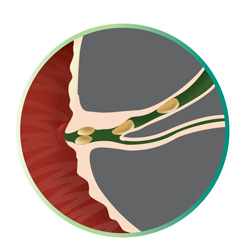 Here are two basic things you need to know about gallstones: They are painfully common—and commonly painful. Nearly 1 million people in the U.S. every year learn they have gallstones. And about a quarter of them will need to have some sort of treatment, usually surgery to remove their gallbladder.
Here are two basic things you need to know about gallstones: They are painfully common—and commonly painful. Nearly 1 million people in the U.S. every year learn they have gallstones. And about a quarter of them will need to have some sort of treatment, usually surgery to remove their gallbladder.
So what exactly are gallstones and why can they sometimes be so painful?
The trouble with stones
Gallstones are hard, abnormal masses that form in the gallbladder—a small, saclike structure located just under your liver. The main function of your gallbladder is to store bile, a liquid made by your liver that aids in digesting fats.
Bile is made up of several substances, including cholesterol, bile salts and bilirubin (a waste product). Gallstones may form when bile contains too much cholesterol or bilirubin or not enough bile salts, causing digestive fluid to harden into a stone.
Gallstones can be quite tiny—like the size of a grain of sand—or as large as a golf ball. You can have one or more stones, and they can be a mix of large and small sizes.
Painful attacks
Many times gallstones cause no symptoms and don't need treatment. However, sometimes a gallstone blocks a bile duct, triggering a painful gallbladder attack.
Many people have an attack after a large meal, and most attacks happen in the evening or at night. You'll feel the pain in your right upper abdomen, and the attack can last for several hours. An attack usually stops when a gallstone moves and no longer blocks the bile duct. But if that stone doesn't move and the attack doesn't stop, then you're at risk for serious complications, which include inflammation of the gallbladder, liver or pancreas.
If your attack doesn't stop or if you experience any of the following symptoms during or after a gallbladder attack, you need to get medical help right away:
• Nausea or vomiting.
• Fever or chills.
• Jaundice—your skin and the whites of your eyes look yellowish.
• Dark urine or light-colored stools.
Treatment options
Many people can simply live with gallstones if the stones don't bother them or don't trigger frequent attacks. But treatment is often needed.
Gallstones can be treated with medications and therapies that dissolve them, but the stones can return. Which is why surgery to remove the gallbladder—called a cholecystectomy—is the usual treatment for bothersome stones. And, fortunately, the body functions just fine without a gallbladder.
Watson Clinic’s General Surgery team performs a comprehensive catalog of surgical procedures, including gallstone procedures. Dr. Thomas Moskal was the first specialist in Lakeland to perform gallbladder removal procedures utilizing only a single 1-inch incision. Performed with robotic surgery technologies, the procedure resulted in a shorter hospital stay, a significantly faster recovery time, and a virtually undetectable scar. For more information, visit WatsonClinic.com/GeneralSurgery.
Source: National Institute of Diabetes and Digestive and Kidney Diseases